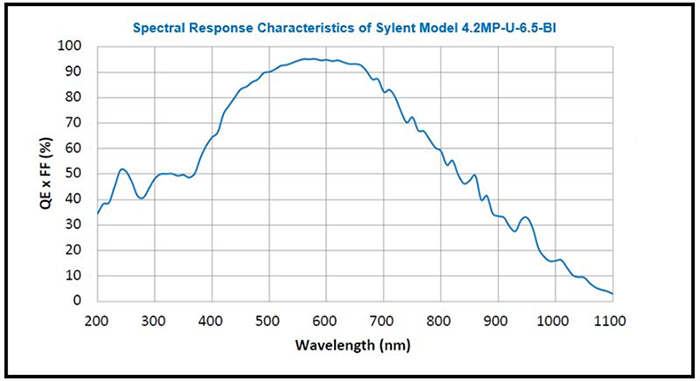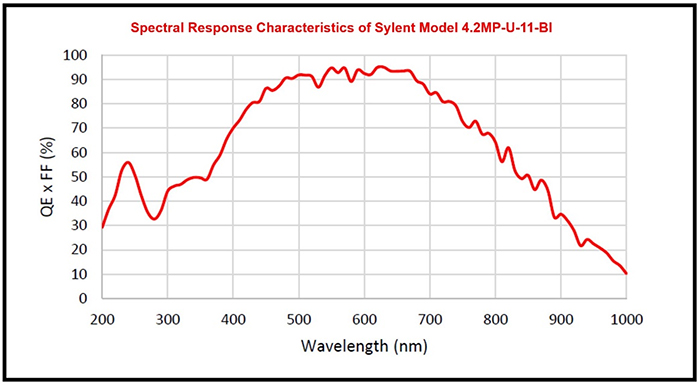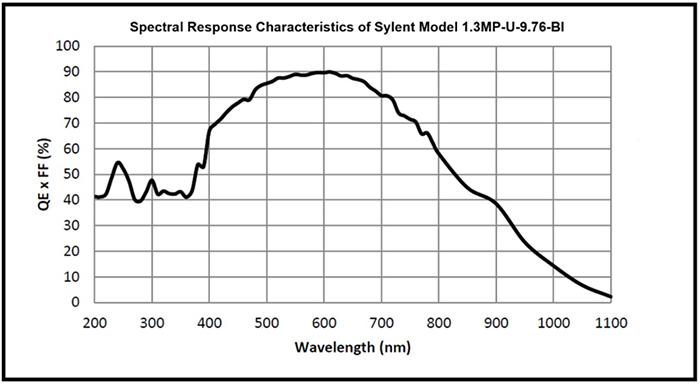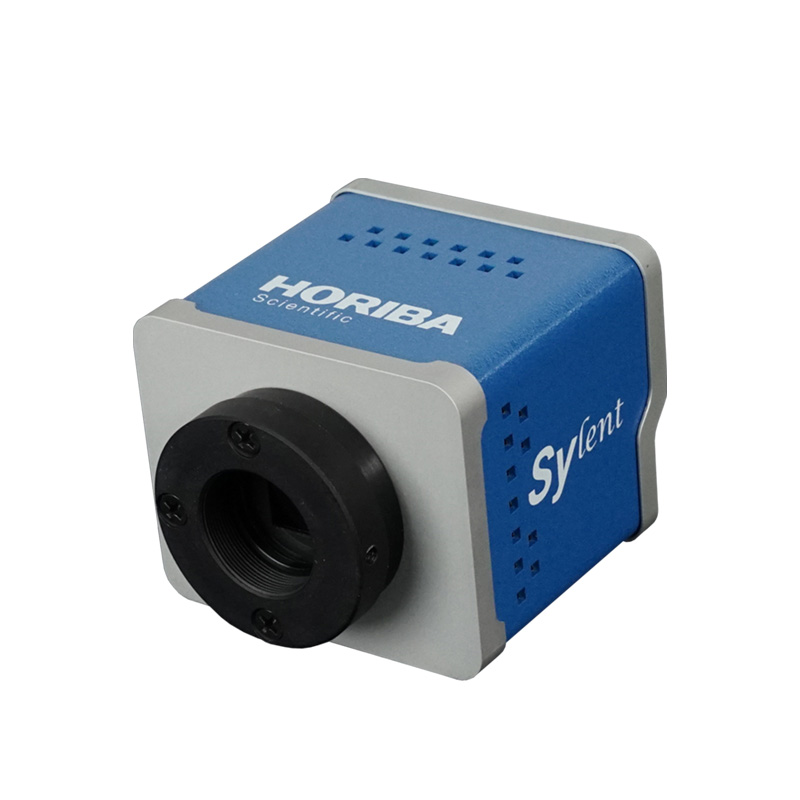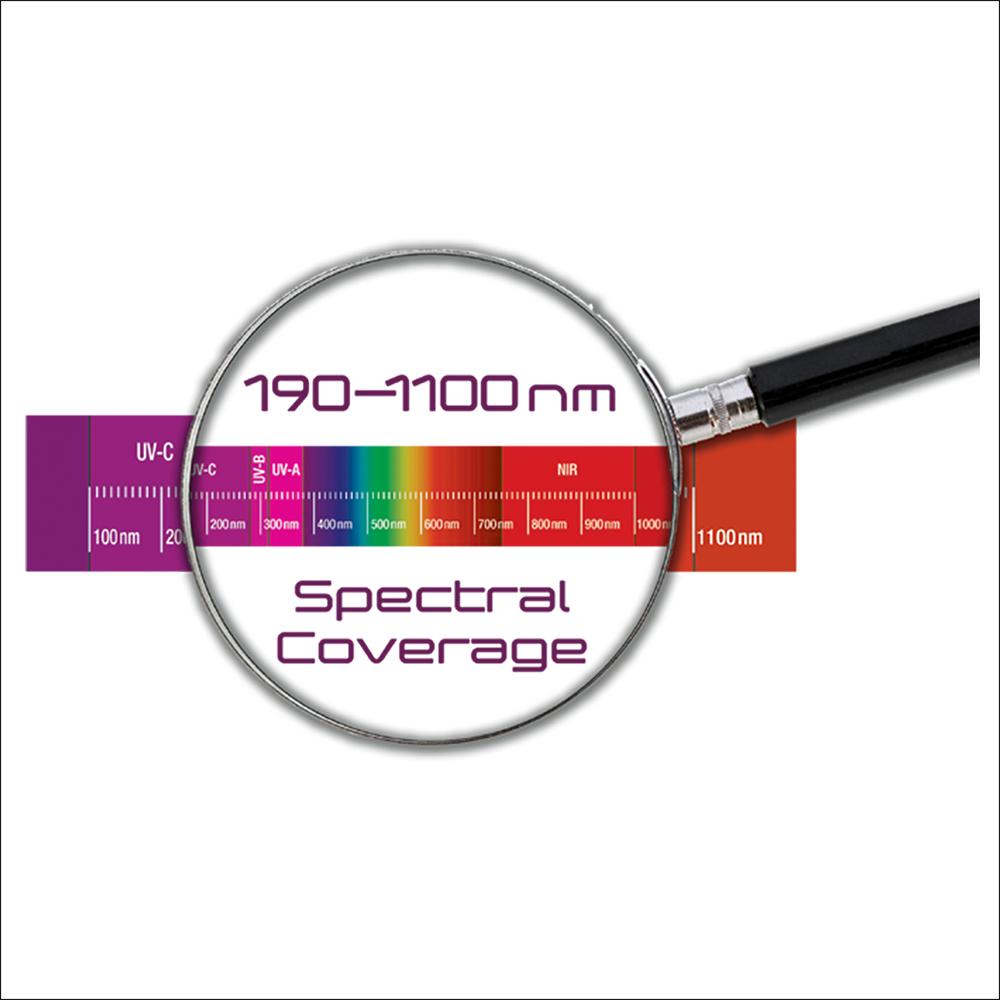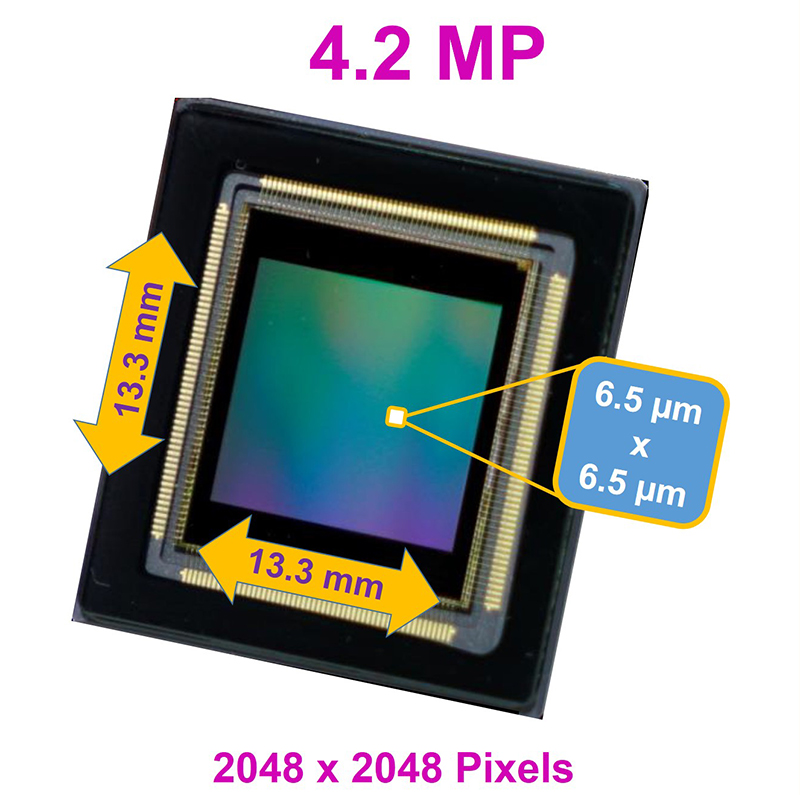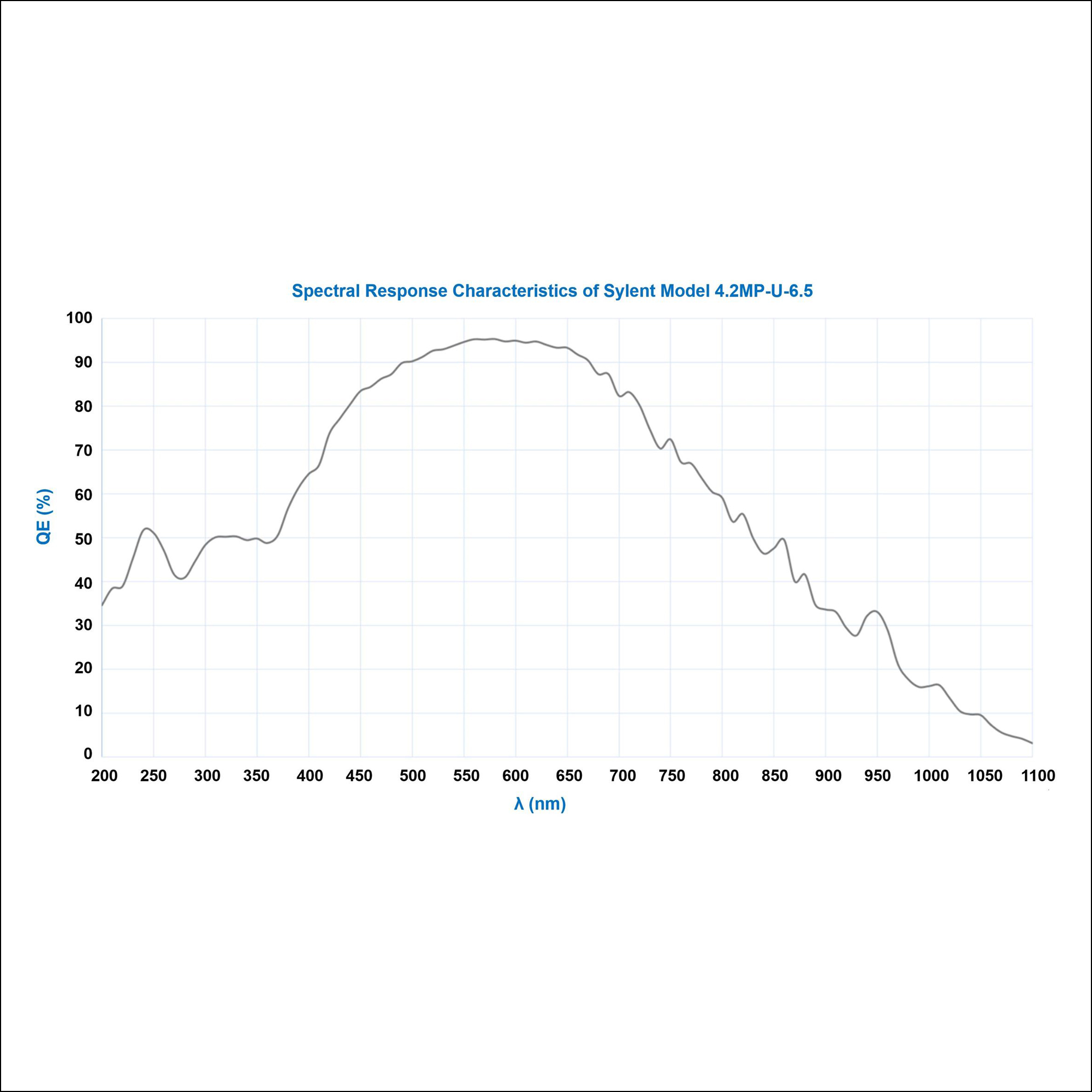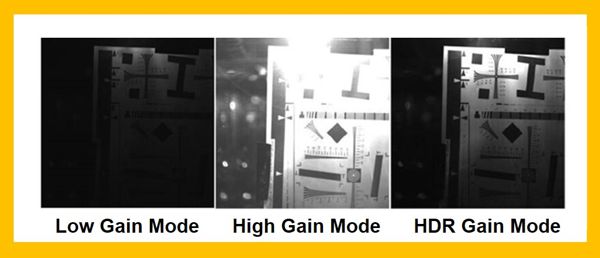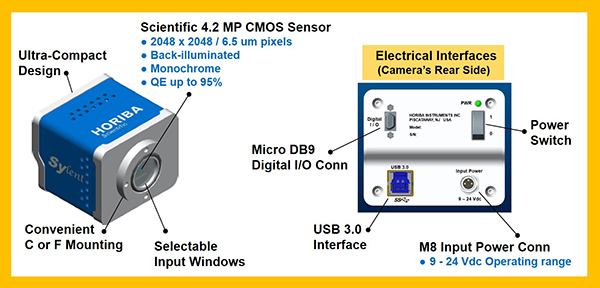| General Camera Specifications* – 6.5 μm pixel size | ||
|---|---|---|
| Scientific CMOS Camera Attribute | Sylent Model 4.2MP-U-6.5-BI | |
| Scientific CMOS Sensor Type | Monochrome / Back-Illuminated (Front-illuminated upon request) | |
| Effective Pixels | 4.2 Mega Pixel / Monochrome | |
| Active Pixels | 2048 x 2048 | |
| Pixel size (μm) | 6.5 x 6.5 | |
| Active Photosensitive Area (mm) | 13.3 x 13.3 (Optical format: 1.2" / Diagonal 18.9 mm) | |
| Full Well | 55 ke¯ typ | 50 ke¯ min |
| Linear Full Well | 53 ke¯ typ | 48 ke¯ min |
| Read Noise Median | 1.6 e¯ typ | 2.5 e¯ max |
| Read Noise Median (2-CMS) | 1.2 e¯ typ | |
| Dynamic Range (HDR) | 31,623:1 (90 dB) typ | |
| Non-Linearity | <0.6% | |
| Quantum Efficiency | Up to 95% | |
| Shutter Mode | Rolling | |
| Exposure Time | 11.2 micro-second to seconds (defined only by Dark Current) | |
| Image Time Stamp Accuracy | Coarse: 1 micro-second | Fine: 20 nano-second |
| Triggering Modes (Frame Synchronization) | Internal Sync | |
| External Sync --- Single or Multiple Triggers | ||
| External Sync --- Single / Multiple Triggers with Delays | ||
| Pixel Readout Rates | 50 MHz | |
| Frame Rates (fps) | 16 / 12 Bit | |
| 2048 x 2048 | 43 | |
| 2048 x 1024 | 87 | |
| 2048 x 512 | 174 | |
| Communication | USB 3.0 | |
| External I/O Connector | 9-Pin Micro D-Sub | |
| Power Connector | 3-Pin M8 | |
| Power On / Off Switch | Yes | |
| Environmental Conditions | Operating Temperature Range: +15 0C to +40 0C | |
| Operating Humidity Range: <70% (non-condensing) | ||
| Storage Temperature Range: -20 0C to +60 0C Input | ||
| Input Voltage Range | +9 to +24 Vdc | |
| Input Power | 7.5 W typ (24 Vdc @ 0.329 Adc) | |
| Cooling | Fan (standard) / TE-cooled Sylent BLUE variant available upon request | |
| Window Material | Selectable / UV Grade Fused-Silica (Standard) | |
| Window Coating | Available AR Coating on request | |
| Lens Mount Adapter | C-Mount (Standard) / F-Mount (Optional) / Customizable on request | |
| Camera Size Without C-Mount | Inches: 2.38 x 2.87 x 2.94 | mm: 60.4 x 72.9 x 74.7 |
| Camera Size With C-Mount | Inches: 2.38 x 2.87 x 3.31 | mm: 60.4 x 72.9 x 84.1 |
| Weight | Lbs: 0.70 | Grams: 318 |
| Software Support | Custom API/SDK support for easy integration to C#, C++ applications and container applications supporting standard DLL library interface. Consult factory for 3rd party imaging software support. | |
* Specification values subject to change
***See sensor manufacturer’s Blemish / Defect information
| General Camera Specifications* – 11 μm pixel size | ||
|---|---|---|
| Scientific CMOS Camera Attribute | Sylent Model 4.2MP-U-11-BI | |
| Scientific CMOS Sensor Type | Monochrome / Back-Illuminated (Front-illuminated upon request) | |
| Effective Pixels | 4.2 Mega Pixel / Monochrome | |
| Active Pixels | 2048 x 2048 | |
| Pixel size (μm) | 11 x 11 | |
| Active Photosensitive Area (mm) | 22.528 x 22.528 (Optical format: 2" / Diagonal 31.859 mm) | |
| Full Well | 91 ke¯ typ | |
| Linear Full Well | 89 ke¯ typ | |
| Read Noise Median | 1.6 e¯ typ | |
| Dynamic Range (HDR) | 50000:1 (93.9 dB) typ | |
| Non-Linearity | <1% | |
| Quantum Efficiency | Up to 95% | |
| Shutter Mode | Rolling | |
| Exposure Time | 20.52 micro-second to seconds (defined only by Dark Current) | |
| Image Time Stamp Accuracy | Coarse: 1 micro-second | Fine: 20 nano-second |
| Triggering Modes (Frame Synchronization) | Internal Sync | |
| External Sync --- Single or Multiple Triggers | ||
| External Sync --- Single / Multiple Triggers with Delays | ||
| Pixel Readout Rates | 25 MHz | |
| Frame Rates (fps) | 16 / 12 Bit | |
| 2048 x 2048 | 22 | |
| 2048 x 1024 | 44 | |
| 2048 x 512 | 94 | |
| Communication | USB 3.0 | |
| External I/O Connector | 9-Pin Micro D-Sub | |
| Power Connector | 3-Pin M8 | |
| Power On / Off Switch | Yes | |
| Environmental Conditions | Operating Temperature Range: +15 0C to +40 0C | |
| Operating Humidity Range: <70% (non-condensing) | ||
| Storage Temperature Range: -20 0C to +60 0C Input | ||
| Input Voltage Range | +9 to +24 Vdc | |
| Input Power | 7.5 W typ (24 Vdc @ 0.329 Adc) | |
| Cooling | Fan (standard) / TE-cooled Sylent BLUE variant available upon request | |
| Window Material | Selectable / UV Grade Fused-Silica (Standard) | |
| Window Coating | Available AR Coating on request | |
| Lens Mount Adapter | C-Mount (Standard) / F-Mount (Optional) / Customizable on request | |
| Camera Size Without C-Mount | Inches: 2.38 x 2.87 x 2.94 | mm: 60.4 x 72.9 x 74.7 |
| Camera Size With C-Mount | Inches: 2.38 x 2.87 x 3.31 | mm: 60.4 x 72.9 x 84.1 |
| Weight | Lbs: 0.70 | Grams: 318 |
| Software Support | Custom API/SDK support for easy integration to C#, C++ applications and container applications supporting standard DLL library interface. Consult factory for 3rd party imaging software support. | |
* Specification values subject to change
*** See sensor manufacturer’s Blemish / Defect information
| General Camera Specifications* – 9.76 μm pixel size | ||
|---|---|---|
| Scientific CMOS Camera Attribute | Sylent Model 1.3MP-U-9.76-BI | |
| Scientific CMOS Sensor Type | Monochrome / Back-Illuminated (Front-illuminated upon request) | |
| Effective Pixels | 1.3 Mega Pixel / Monochrome | |
| Active Pixels | 1280 x 1024 | |
| Pixel size (μm) | 9.76 x 9.76 | |
| Active Photosensitive Area (mm) | 12.493 x 9.994 (Optical format: 1" / Diagonal 15.998 mm) | |
| Full Well | 48 ke¯ typ | TBD ke¯ min |
| Linear Full Well | TBD ke¯ typ | TBD ke¯ min |
| Read Noise Median | 1.6 e¯ typ | TBD e¯ max |
| Read Noise Median (2-CMS) | 0.85 e¯ typ | |
| Dynamic Range (HDR) | 29,854:1 (89.5 dB) typ | |
| Non-Linearity | <0.6% | |
| Quantum Efficiency | Up to 90% | |
| Shutter Mode | Rolling | |
| Exposure Time | 10 micro-second to seconds (defined only by Dark Current) | |
| Image Time Stamp Accuracy | Coarse: 1 micro-second | Fine: 20 nano-second |
| Triggering Modes (Frame Synchronization) | Internal Sync | |
| External Sync --- Single or Multiple Triggers | ||
| External Sync --- Single / Multiple Triggers with Delays | ||
| Pixel Readout Rates | 37.125 MHz | |
| Frame Rates (fps) | 16 / 12 Bit | |
| 1280 x 1024 (HDR) | 30 | |
| 1280 x 1024 (2-CMS) | 25 | |
| Communication | USB 3.0 | |
| External I/O Connector | 9-Pin Micro D-Sub | |
| Power Connector | 3-Pin M8 | |
| Power On / Off Switch | Yes | |
| Environmental Conditions | Operating Temperature Range: +15 0C to +40 0C | |
| Operating Humidity Range: <70% (non-condensing) | ||
| Storage Temperature Range: -20 0C to +60 0C Input | ||
| Input Voltage Range | +9 to +24 Vdc | |
| Input Power | 7.5 W typ (24 Vdc @ 0.329 Adc) | |
| Cooling | Fan (standard) / TE-cooled Sylent BLUE variant available upon request | |
| Window Material | Selectable / UV Grade Fused-Silica (Standard) | |
| Window Coating | Available AR Coating on request | |
| Lens Mount Adapter | C-Mount (Standard) / F-Mount (Optional) / Customizable on request | |
| Camera Size Without C-Mount | Inches: 2.38 x 2.87 x 2.94 | mm: 60.4 x 72.9 x 74.7 |
| Camera Size With C-Mount | Inches: 2.38 x 2.87 x 3.31 | mm: 60.4 x 72.9 x 84.1 |
| Weight | Lbs: 0.70 | Grams: 318 |
| Software Support | Custom API/SDK support for easy integration to C#, C++ applications and container applications supporting standard DLL library interface. Consult factory for 3rd party imaging software support. | |
* Specification values subject to change
*** See Sensor manufacturer's blemish defect information
IMAGING MODE FRAME RATES
| Sensor ROI Size | 4.2MP-U-6.5-BI | 4.2MP-U-11-BI | ||
|---|---|---|---|---|
| W x H (Pixels) | Frame Rate (fps) | ROI Area mm x mm | Frame Rate (fps) | ROI Area mm x mm |
| 2048 x 2048 | 43 | 13.3 x 13.3 | 23 | 22.5 x 22.5 |
| 1400 x 1400 | 63 | 9.1 x 9.1 | 34 | 15.4 x 15.4 |
| 1200 x 1200 | 74 | 7.8 x 7.8 | 40 | 13.2 x 13.2 |
| 1024 x 1024 | 87 | 6.7 x 6.7 | 47 | 11.3 x 11.3 |
| 512 x 512 | 172 | 3.3 x 3.3 | 95 | 5.6 x 5.6 |
| 256 x 256 | 348 | 1.7 x 1.7 | 287 | 2.8 x 2.8 |
| 128 x 128 | 697 | 0.8 x 0.8 | 367 | 1.4 x 1.4 |
SPECTROSCOPY MODE SPECTRAL RATES
| Sensor Array Size | USB 3.0 Maximum Spectral Rate | ||
|---|---|---|---|
| W x H | 4.2MP-U-6.5-BI | 4.2MP-U-11-BI | |
| 16 / 12 Bit | 16 / 12 Bit | ||
| Any x 8 | 6,944 | 3,891 | |
| Any x 16 | 4,255 | 2,375 | |
| Any x 32 | 2,415 | 1,335 | |
| Any x 64 | 1,294 | 711 | |
| Any x 1200 | 74 | 40 | |
| Any x 2048 | 43 | 23 | |
MULTI-TRACK MODE EXAMPLE USING SYLENT
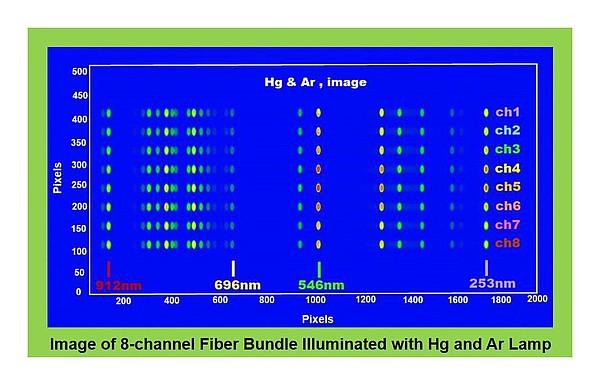
Sylent Quantum Efficiency
